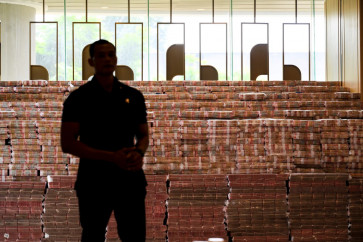Popular Reads
Top Results
Can't find what you're looking for?
View all search resultsPopular Reads
Top Results
Can't find what you're looking for?
View all search resultsExecutive column: IDX volatile in 2012, promising in long term
The Indonesia Stock Exchange (IDX) was among the world’s best performing bourses last year, along with the Dow Jones and the Philippines SE Index, despite only posting a modest 3
Change text size
Gift Premium Articles
to Anyone
T
he Indonesia Stock Exchange (IDX) was among the world’s best performing bourses last year, along with the Dow Jones and the Philippines SE Index, despite only posting a modest 3.2 percent gain as the effects of the
economic crisis in Europe continued.
Amid the ongoing eurozone crisis, Trimegah Securities president director Omar S. Anwar shared his views with The Jakarta Post’s Moch N. Kurniawan on the country’s capital markets situation, not only for this year but also for the medium to long term.
Question: How do you see the Indonesian capital markets now and in the future?
Answer: Indonesia has just regained its investment grade status after losing it in the 1997/1998 economic crisis. From 2010 to 2025, Indonesia will become one of the world’s top 10 economic powerhouses, while at present we are rank at 17. Our gross domestic product (GDP) is US$700 billion, and for this to grow one of the contributors will be the capital markets, which reflect the development of a country. For example, In Malaysia, the stock market capitalization to GDP ratio has reached 37 percent, Thailand is higher, but Indonesia is still less than 20 percent.
In the future, we will need 1,500 to 2,000 publicly listed companies, compared to 500 at present. It is better if more and more prospective companies list their shares on the IDX as this will improve market liquidity, which is currently $500 million a day, far below Singapore at $2.5 billion a day. IDX needs to achieve the level of Singapore in order to encourage foreign investors to bring their money here, thus giving opportunities to local companies to grow and expand at home and overseas.
To reach the level you have just mentioned, what are the requirements?
As repeatedly mentioned by the government, our infrastructure such as roads, seaports, airports, electricity must be improved to achieve a 7.5-8 percent growth, as our economic growth is still mainly reliant on domestic consumption. Consumption should be promoted outside Java as 60 percent of consumption is now absorbed in Jakarta. More entrepreneurs are needed, and there is rising a trend of wealth creators coming from outside Java. For the capital markets sector, this is an opportunity to attract disposable income from individual and corporate investors.
If people are richer, they will start investing to seek higher returns, not simply saving. People can be active investors by trading shares on the stock exchanges or passive through buying into mutual funds. For corporate bodies, their pension funds, for instance, can also diversify their portfolios not only in the form of bonds and time deposits, but in shares. For companies that are willing to go public or issue bonds, securities companies can assist them as well. As Indonesia re-attains investment grade, interest rates consequently drop. Firms will refinance or pay off their debts and issue bonds to save costs.
About the eurozone crisis, how will it affect the IDX this year?
The eurozone crisis is not over yet. Our research team sees this year as a year of two halves. In the first semester, the market will await policy-driven decisions in the eurozone, including in France and Germany. There is no solution yet for the crisis in Europe.
Indonesia, despite its strong economic growth, will be affected by the eurozone crisis including its capital markets. We predict that the IDX will be very volatile in the first and second quarter. The small caps valuation and price-to-earnings ratios are now equal to blue chips, while those in mid caps are lower. This situation is not normal, the small caps are overvalued, so there should be a correction. Investors who hold small caps should sell their portfolio now while the prices are still high.
In the second semester, publicly listed companies with strong fundamentals will outperform others. The consumer sector, commodities, banking with low valuations will see the benefits. The IDX may reach 4,250-4,500 by the end of this year.
You are optimistic that by the end of this year the IDX will be in bullish mode. However, looking back at last year, there was a similar prediction, but in the end the IDX only gained 3.2 percent. How do you see that?
Last year, in August, there was a crisis in the eurozone involving Greece and Italy. The exposure was high and it created volatility in capital markets including the IDX until November. The IDX, which we predicted would reach 4,500 last year, dropped to 3,200 before making a rebound to 3,650. The volatility will continue in the first half of this year as there is no solution yet to the eurozone crisis. We expect there will be a good decision to resolve the crisis in June 2012. However, even if there is no decision, the markets will automatically adjust and foreign funds will flow in here.
What should the IDX do to bring in more foreign cash amid the eurozone crisis?
Liquidity is the key. The market must be bigger if we want big fund managers to invest their money here. IDX liquidity of $500 million a day is not big, compared to a transaction made by one big foreign fund manager of $100 million to $200 million a day. We can’t absorb such huge funds at once; at the end we can absorb between $10 million and $40 million, which is fine. I just hope there will be a gradual increase, not a shocking one.
The number of local investors in the capital markets is not very high. How should this be increased?
At present, the number of local investors that trade shares only stands at 400,000. It should be 1 percent of the population or 2.4 million. To achieve that number, referring to India’s experience, there must be a “bull market” for two consecutive years as this raises local investor confidence. However, Indonesian investors have also learned from past crises, such as in 2008 when the IDX dropped, it was time to buy [shares].
I am also sure that savers will finally realize that their 2-percent annual return is very low compared to investing in capital markets. So don’t be surprised if we see the number of local investors suddenly jumping to 2.4 million. Access to share-trading is everywhere now; just log on to the Internet and you can have an online account. That’s for investors who trade shares. In mutual funds, local investors number about 700,000 people. They are the people who are slowly transferring their savings into mutual funds. At present, bank liquidity is still high and 55 to 60 percent of the funds come from retail/personal, not from corporate investors. The investors in mutual funds should also grow by four times from the current level.










